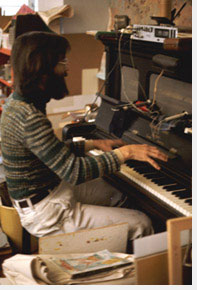

| Exhibition
| Chronology | Works
| Catalog
| Literature
| Press
| Trailer Visitor Information | Program | Partner | Credits | Deutsch |
|
Tony Conrad  Tony Conrad's artistic creativity cannot be subsumed by any one category. He is certainly best known as a musician and film-maker, yet he is also a painter, a video- and performance artist, and at the same time a mediator of his knowledge by means of quantities of writings and teaching activities. Tony Conrad's artistic creativity cannot be subsumed by any one category. He is certainly best known as a musician and film-maker, yet he is also a painter, a video- and performance artist, and at the same time a mediator of his knowledge by means of quantities of writings and teaching activities. As a violinist he was among the founders of Minimal music, which developed as Minimal art's accompaniment in the 1960s. Inspired by Jack Smith, pioneer of underground films in New York, and Beverly Grant, his first wife, he turned to the medium of film. In 1966, Conrad made Flicker, one of the key works of structural film. The alternation between dark and light images with varying frequencies is often the medium of such experimental films. Over the years, he had been creating films such as Coming Attraction, Straight and Narrow [both 1970] or Articulation of Boolean Algebra for Film Opticals [1975], and videos such as Phonograph and Cycles of 3's and 7's [both 1977], Hail the Fallen [1981], and In Line [1986]. While the films primarily deal with perceptual problems, he often makes use of narrative structures in his video works. In the 1970s, Conrad began to occupy himself more with socio-cultural power structures. With his teaching position in the Department of Media Study at SUNY, Buffalo, an involvement with structures of control and authority increasingly began to have significance for him. Conrad is still active at SUNY, Buffalo, teaching video production and analysis. Tony Conrad has become a central figure for many media artists of a younger generation [for example Tony Oursler and Mike Kelley, among others] because of his having left the Modernist formal tradition, among whose masters he had belonged to in the 1960s, behind. |
|